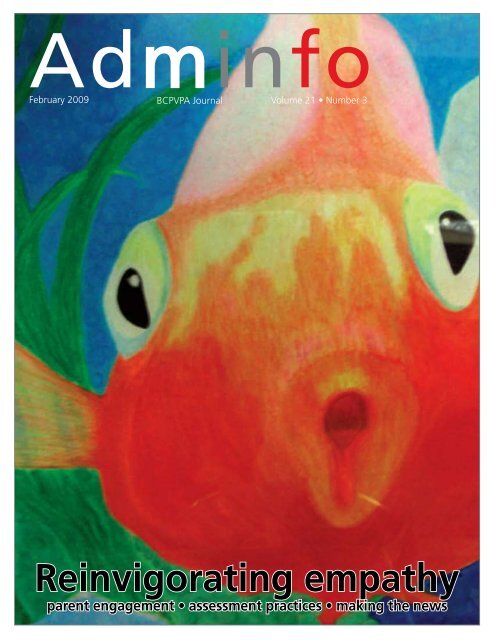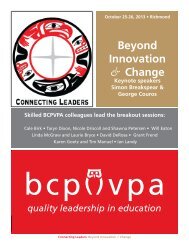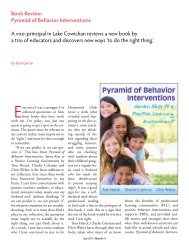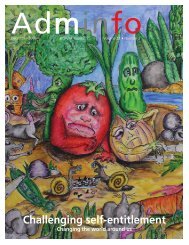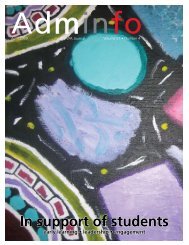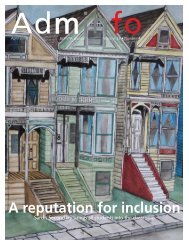Reinvigorating empathy - and Vice Principals
Reinvigorating empathy - and Vice Principals
Reinvigorating empathy - and Vice Principals
- No tags were found...
Create successful ePaper yourself
Turn your PDF publications into a flip-book with our unique Google optimized e-Paper software.
AdminfoFebruary 2009 Volume 21 • Number 3BCPVPA Journal<strong>Reinvigorating</strong> <strong>empathy</strong>parent engagement • assessment practices • making the news
Let’s talk about parent engagementBCPVPA President Marilyn Merler offers some practical ideasabout how to engage parents with their children’s schoolsStudent engagement is a popularexpression in the worldof education. It certainly hascome up a lot at the past few conferencesI’ve attended. So, to remaincutting edge, let’s talk about engagement,but let’s talk about parent engagement.When parents are activelyinvolved with their children’s school,students benefit. As principals <strong>and</strong>vice-principals, our role is to encouragepositive parental involvement inour schools <strong>and</strong> that is possible inmany ways. Here are some ideas onengaging parents that I have witnessedor enacted over the years.Make your schoola welcoming place for parentsStart by being visible in the hallwaysat the beginning <strong>and</strong> endof the school day, when parents maybe dropping off or picking up theirchildren. This happens more frequentlyin elementary schools, butthere are still a few parents w<strong>and</strong>eringaround middle <strong>and</strong> high schoolsat the beginning or end of the schoolday. Use the student’s name whengreeting them <strong>and</strong> if you don’t knowthe parent’s name ask the studentto introduce their parent to you. Ina large school, it would be virtuallyimpossible to remember all of theparent names, but parents appreciatethat you know their children’snames. St<strong>and</strong> at one of the entrancesto the school every morning<strong>and</strong> greet people as they come in.At the end of the day, walk aroundthe hallways <strong>and</strong> stop to chat withparents. On the first day of school,once the students are settled intotheir new classes, invite parents tothe staffroom <strong>and</strong> offer them coffee<strong>and</strong> snacks. This works well in theelementary setting, when you havemany parents who are worried aboutleaving their children. This way parentsare still in the school, getting toknow other parents, <strong>and</strong> the teacherscan get on with their job of gettingto know the students. The more welcomeparents feel in the school, themore time they will spend there, <strong>and</strong>the more time they spend at school,the deeper their engagement.Have a place whereparents can congregate?Parents enjoy having a comfortableplace to sit <strong>and</strong> chat witheach other while waiting for theirchildren. Try joining them sometimeto ask their opinion aboutsomething related to the school, forexample, “How is your child enjoyingour daily physical activity (DPA)program?” Or “Are you planning oncoming to the Family Math Nighttomorrow night?” Some schoolshave established parent rooms ordesignated portions of rooms forparent use. One parent room I sawFebruary 09 • Adminfo • 2had comfortable chairs <strong>and</strong> couches,coffee, toys for preschool children,<strong>and</strong> an excellent parent referencearea with all kinds of resources, includingcopies of the IRPs, parentingbooks, videos, DVDs, CDs, children’sbooks <strong>and</strong> novels, that couldall be signed out. There was also abulletin board with the school <strong>and</strong>PAC newsletter, the School Plancontinuespage 4Board of Directors 2008–2009Ma r i l y n Merler, Presidentmmerler@bcpvpa.bc.caLes Du k o w s k i, Pa s t-Presidentldukowski@bcpvpa.bc.caDirectorsLeslie Andersson<strong>and</strong>ersson_l@sd36.bc.caJameel Azizjaziz@sd73.bc.caBr i a n Chappellbchappell@sd57.bc.caCh e r y l Dewcheryl.dew@sd27.bc.caBr i a n Ja c k s o nBrian.Jackson@sd41.bc.caCl a u d e t t e La v o i eclavoie@sd50.bc.caEl a i n e McVieemcvie@sd61.bc.caMy l e s Mo w a tMyles_Mowat@sd59.bc.caCa r l Reppcrepp@sd62.bc.caPa u l Ta y l o rtaylor_paul@sd36.bc.caISSN: 1201-4214
February 09 • Adminfo • 3
At one PAC meeting, my vice-principal <strong>and</strong> I tookparents through the six assessment for learningstrategies <strong>and</strong> explained how teachers were usingthem. In the next PAC newsletter, one of theparents wrote an excellent article about assessmentfor learning. Now that’s an engaged parent!ning Council report, a message area,as well as a computer. This room wasused frequently <strong>and</strong> parents took responsibilityfor it.Keep your parents informedParents who read the school <strong>and</strong>PAC newsletter are informedparents, but only to a certain extent.Through the newsletter we makethem aware of our school goals<strong>and</strong> its progress, special events, theschool calendar, student/staff recognition<strong>and</strong> concerns such as theparking lot at the end of the dayor the overflowing lost <strong>and</strong> found.But newsletters can’t give parents anin-depth underst<strong>and</strong>ing about theschool <strong>and</strong> how it operates. Schoolwebsites have the potential to fillthat need <strong>and</strong> I have witnessed theirincreasing usefulness for parents.Not only can a wealth of informationabout the school be a fingertipaway, but also there is the potentialfor valuable interaction.For parents who do come intothe school, make sure that yourschool goals <strong>and</strong> mission statementare posted in a highly visible place.Support your goals with student evidence,either in the form of work orphotographs (<strong>and</strong> change them frequently).Students <strong>and</strong> parents loveto see their work <strong>and</strong> photos in thehallways.Many parents are interested inknowing how things are done atschool. For example, how do youdetermine the class lists? This is acomplex procedure in most schools<strong>and</strong> for most parents, it is not clearhow this happens. Last year, at aspecially-advertised PAC meeting,I took our parents through the procedurewe used at our school to setclasses in June for the following year.Using a fictitious group of 68 gradetwo students <strong>and</strong> fictitious teachers,parents had the opportunity toplace these students in the appropriategrade three class. I made up individualstudent information cards,which described the learning needsof each student. I also gave someinformation about each fictitiousteacher. There were a variety of optionsfor grade three; a male teacher,two female teachers, a shared class,a 2/3 combined class, <strong>and</strong> as in reallife, each teacher had a distinct style<strong>and</strong> special interest, such as musicor computers. I divided the parentsinto teams, each team representing agrade two teacher who had the taskof placing their students in a gradethree class. The parents took theirroles seriously <strong>and</strong> spent an hour onthe task. There was rich discussion<strong>and</strong> many excellent questions. At theend of the activity, all parents saidthat they had no idea how complex,respectful <strong>and</strong> difficult the task ofstudent placement was. I have triedthe same approach with a schoolwidewrite marking session, using thePerformance St<strong>and</strong>ards. When parentshad the opportunity to use the PerformanceSt<strong>and</strong>ards to assess studentwriting, they had a much better underst<strong>and</strong>ingof the tool <strong>and</strong> how theirchildren’s writing is assessed. As effectiveteachers know, active participation,rather than “sit <strong>and</strong> get” willresult in deeper learning.Here are some other active participationideas: Lead parents throughsome of your DPA, such as “brainbreaks” or a few of the exercises inthe Action Schools! BC kit. At yournext science fair, have a parent projectcategory, where parents can submittheir own science fair project. Ihave done this <strong>and</strong> had some excellentsubmissions. Invite parent guestspeakers to make presentations toclasses. Ask your PAC president tospeak at the beginning of each staffmeeting. Be a guest presenter at aPAC meeting <strong>and</strong> give a mini- sessionon a conference or workshopyou attended. At one PAC meetinglast year, my vice-principal <strong>and</strong>I took parents through the six assessmentfor learning strategies <strong>and</strong>explained how teachers were usingthem in their classrooms. In the nextPAC newsletter, one of the parentswrote an excellent article about assessmentfor learning. Now that’s anengaged parent! Set up some parent-studentnights in your school,such as computer night, where studentsshow their parents some ofthe programs they are using <strong>and</strong>parents have the opportunity to trythem out. Many schools organizeFamily Math Night or Family LiteracyNight. Have a suggestion boxfor both parents <strong>and</strong> students in aprominent place in your school or avirtual one on your school website.When we involve parents beyondschool fundraising, we have moreengaged parents <strong>and</strong> everyone benefits.Parents are a valuable part ofthe learning team at all schools <strong>and</strong>as principals <strong>and</strong> vice-principals, wehave a role in helping them to becomeengaged learners.February 09 • Adminfo • 4
Shifting the processChanging the assessment practices of anoutreach learning team in Southern Albertaby Lori IsbergThis paper explores three keyconcepts in Dylan Wiliam’s(2008) Changing ClassroomPractice: changing the design of schools,formative assessment, <strong>and</strong> knowing iseasier than doing. The paper will befrom an Alberta outreach educator’sperspective, specifically a teacherwho works at an outreach school inrural southernAlberta. Outreachschools<strong>and</strong> programs inAlberta are designedto workwith youth whoalready have orare in dangerof dropping outof a traditionalhigh school.Each schoolor program isunique to thepopulation itserves <strong>and</strong> theschool districtit is locatedin. EducationPlus, HighRiver Campus,is one of four outreach schools inthe Foothills School Division. Inmy division, four outreach schoolshave decided to work together withthe m<strong>and</strong>ate to create a professionallearning community to see if student’sbecome more engaged in theirown learning using formative assessmentas the basis of dialogue. Tak-February 09 • Adminfo • 5ing a critical look at Wiliam’s (2008)paper is a natural point of departurefor this new learning team.BackgroundHigh school teachers tend tohead to their curriculum corners,coming out for the promiseof free food or fresh coffee. Professionallearning communities in highschools also tend to be curriculumsegregated. My experience in teachingin an outreach, alternative highschool in Alberta is an exciting, yetisolating career choice. My own professionaldevelopment has focusedon how to run a school without aprincipal on site, how to teach over50 subjects, <strong>and</strong> how to ensure thefocus remains on student learning.Outreach students are at-risk youthwho are in danger of not completingtheir high school education, aswell as youth who are looking for amore flexible way to obtain a highschool diploma. Most of the coursework is delivered through distributedlearning material, with teachersmarking <strong>and</strong> working with studentsindependently.(continues next page)
A conversation about caringA teacher <strong>and</strong> principal chat about social-emotional developmentby Sean CookSean (l) <strong>and</strong> Rob Zambranoshare an informal conversationabout social-emotionaldevelopment.Teaching high school Englishprovides an importantglimpse into the social-emotionaldevelopment of young people.In the English classroom, the studyof human emotion — particularlythose of characters in conflict — iscentral to the curriculum. Years ofwatching students respond to imaginedexperiences with values gainedfrom real life experiences has givenme a front row seat — one mightsay season’s tickets — at the spectacleof adolescent social-emotionaldevelopment.Unfortunately, things don’t seemto be going so well. Apart from welldocumented increases in depression<strong>and</strong> anxiety, there seems to be a levelof preoccupation or distraction thatincreasingly limits students’ capacityto care deeply about their studies.With this in mind, I was pleasedto participate in the Dare to Careprogram at Centennial SecondarySchool in Coquitlam during the lastweek of October. Using both largeassemblies <strong>and</strong> small group interaction,the Dare to Care team ofDwayne Peace <strong>and</strong> Mike HanlonFebruary 09 • Adminfo • 8were surprisingly successfulat reinvigorating the students’<strong>and</strong> teachers’ sense of <strong>empathy</strong>,engagement <strong>and</strong> community.These guys are onto something.How long this heightenedsense of <strong>empathy</strong> <strong>and</strong> communitywill endure is anybody’sguess, but one thing is certain: it’sthere, just under the surface.And so, in the spirit of socialemotionaldevelopment, I invitedour principal, Robert Zambrano, toa local eatery for an informal chatabout the experience. Given theever exp<strong>and</strong>ing role of communicationstechnology in our lives, we oftenforget how much can be learnedfrom a friendly chat in a comfortablesetting. Following ten minutesof banter, the following conversationtook place.
Sean: What made you think aprogram focusing on social-emotionaldevelopment was necessary atour school?Rob: Well, working in a numberof schools, one acquires a sense ofhow things ought to be. When I arrivedat the school several monthsago things didn’t seem right. Kidswere interacting in a way that wasdisrespectful, as though the kids whowere on the edge of appropriate behaviorhad more influence than theninety percent of kids doing a greatjob. I had this sense.Sean: Your use of intuition, thisidea of just knowing, reminds me ofMalcom Gladwell’s idea in his book,Blink, that expertise, habit <strong>and</strong> intuitioncan work together almost as asixth sense.Rob: That’s exactly what it is. TheBlink analogy is an excellent one.Sean: Would you consider thisa new way of assessing a problem,given how much we rely on rational,methodical data collection?Rob: I think good teachers, well,anybody who is good at what theydo, whatever it may be, have thissense through the experience ofwatching their intuitions come tofruition. That being said, sometimesyou’re wrong. There was also a steadystream of teachers through my doorsharing their concerns. When Icame across Dare to Care, I thoughtwell, we need to do something, <strong>and</strong>it needs to be big.Sean: Why does it need to bebig?Rob: Because if a goal is not shared<strong>and</strong> developed throughout the entireschool community <strong>and</strong> is notrevisited regularly, if it’s not smackin your face, it’ll never be achieved.As long as we are all at least facingthe same way, <strong>and</strong> have a commonunderst<strong>and</strong>ing of what should be, Ithink that we have a shot at it. Butit’s also important to remember thatthose who look in another way arealso your allies, not your antagonists.They are the ones that keep you honest.They bring positive critique <strong>and</strong>constructive feedback.Sean: According to the DalaiLama, “your enemy is your greatestguru.”Rob: That’s right. I welcome dissent:be prepared for a fight, but I dowelcome it. That being said, sometimesthe principal is put in a positionwhere he or she gets, or needs,to win. This can be positive or negative,depending on the call the leadermakes. Again, it’s very intuitive.Sean: Did Dare to Care live up toyour expectations?Rob: The three-hour assembly wasvery good, albeit long. But it neededto be that long: kids are constantlybombarded through media, peerinteractions <strong>and</strong> negative communityview points. To oppose this, theyFebruary 09 • Adminfo • 9
People need to be brought together toexperience the spectacle of those in authoritysetting the tone for values.needed to be “bombarded” with theconsistent, positive <strong>and</strong> truthful messagesthat may contradict previousbeliefs. After three hours, the kidsseemed acculturated to the new message,<strong>and</strong> their external shell of tryingto be who they were not seemedto have broken down somewhat.Sean: One might say that thespectacle needed to be gr<strong>and</strong> because,in a sense, it was taking backthe power of spectacle from thosewho provide it electronically forcommercial purposes <strong>and</strong> with littleregard for the negative impact it canhave on communities <strong>and</strong> youngpeople in particular.Rob: I’d agree with that. Really,live performance does very well atbringing out the emotions <strong>and</strong> thetrue feelings of people. Similarly, Ibelieve this is what true leadershipis — an emotional experience thatgalvanizes all of the senses.Sean: Interesting. Again this focuson emotion seems to run contraryto an objective, rational or scientificapproach to management.Rob: Even the best scientific researchcontains a degree of emotionalattachment. Scientific theoriesare developed with beliefs <strong>and</strong>beliefs come from experiences <strong>and</strong>emotions.Sean: If I recall correctly, playwrightGeorge Bernard Shaw wrotesomething to the effect that our valuesare acquired through shared stories,jokes <strong>and</strong> dramatic experiences.We then use our reason to come upwith the supporting arguments.Rob: The idea of our “individualstory” played an important role inthe small group sessions with Dareto Care. Students learned that eachindividual has a story, <strong>and</strong> that weshouldn’t rush to judgment based onwhat we assume is someone’s story.Sean: If we don’t know eachother’s stories, whose stories do weknow? The answer seems to take usback to the previous point that ourshared narratives, mostly throughspectacle, no longer seem to be servingus well.Rob: There is also this trend inWestern society of casting blamewhen things go wrong. But really,our own behavior is more importantthan focusing on what we perceiveothers to be doing wrong. Inthe small groups, kids looked insidethemselves to see who they were<strong>and</strong> how they were similar to others.They learned that they could controla lot just by the way they respond<strong>and</strong> act.Sean: You know, our focus on thepower of stories, <strong>and</strong> on influencingthe world with how we respond to itrather than simply conforming to it,approaches what one normally considersspiritual considerations. Doesthis connect again to a diminishedcommitment to the rational ap-Sean (center, on bass) <strong>and</strong> Rob (right, singing) help to set the school tone atCentennial’s Christmas concert, performing with the group, The Staff Infection.February 09 • Adminfo • 10
proach to education?Rob: Absolutely. Now the questionis “how do we continue to buildthat underst<strong>and</strong>ing?” It’s as thoughwe need a small group session everythree months!Sean: People need to be broughttogether to experience the spectacleof those in authority setting the tonefor values.Rob: And the spectacle can bedone in a variety of ways. The smallgroups were intense. You need tocreate this discomfort to learn.Sean: I’ve often felt that slogansof “learning is fun” are not reallytrue, at least for adolescent or adultlearners. Real learning, especially interms of values, forces us to admitwe had it wrong before, <strong>and</strong> beingreminded of our ignorance is not apleasant experience.Rob: Paradigms need to be shaken.Cages need to be rattled but in thecontext of support <strong>and</strong> caring. Theseexperiences also create character.Sean: Were there any surpriseswith the Dare to Care program?Rob: I was surprised by how wellthe teachers took to it.Sean: As a teacher, I can say thatthe small groups allowed students tosee that teachers were caring, compassionate,<strong>and</strong>, dare I say, intelligenthumans. I have a theory that newmedia sets out to conquer old media<strong>and</strong> so-called “old values” by teachingus to not take them seriously. Thelast half-century of electronic mediahas consistently portrayed parents<strong>and</strong> teachers, as … well … bumbling<strong>and</strong> dorky. Sometimes teachers areportrayed as superheroes, but the effectis the same: real ones look dorkyby comparison. In any case, in thesmall groups students learned thatteachers are, in fact, a credible sourceof relevant ideas about their lives.Rob: You know, I really stronglybelieve that kids know that <strong>and</strong> valueit. They just can’t admit it to eachother, for whatever reason. But themajority of kids, even the most difficult,know this.Sean: One big challenge in educationis that the model we use wascreated 100 years ago, with somemodification 40 years ago. But theworld of communication <strong>and</strong> community,<strong>and</strong> therefore the nature ofthe student who arrives at our doors,has changed dramatically. Is it possiblethat we are starting to see theearly stages of a new <strong>and</strong> perhapsmore relevant curriculum?Rob: Yes, but good teachers havealways changed with the times.Our recent accountability movement<strong>and</strong> achievement data movementhas helped push us away fromthat. Because until a kid is settled,teachers don’t have a chance withachievement. Elementary teachershave always known this.Sean: Your use of the word “set-February 09 • Adminfo • 11
tled” reminds me of Maslow’s hierarchyof needs: that until we feelsafe <strong>and</strong> secure, we can’t begin tothink about learning.Rob: That’s exactly right. Andstudents are different today. A recentMaclean’s magazine articlemakes the case that time spent withtelevision <strong>and</strong> video games actuallyrewires the brains of young people.Kids are now able to multi-task inways we’ve never seen before butas a result, they’ve lost some abilityto interact socially, to identity bodycues <strong>and</strong> interpret facial cues.Sean: Scary. We simply need to bearound people. We are social creatures<strong>and</strong> have been since the dawnof time.Rob: And this course of eventsis hindering kids because we knowthat the brain has plasticity <strong>and</strong> thatit changes based on its experiences.Sean: Perhaps we should teachour students the harmful effects ofsome mental environments: for example,that sitting in front of theTV or computer screen too muchwill desocialize you. One simpleidea could change forever the decisionsthat a person will make.Rob: This goes back to the socialemotional<strong>and</strong> social intelligencepiece of “knowing thyself. ” As aperson, how do I respond to thissituation?Sean: If the most important goalis to know thyself, <strong>and</strong> your actualrelationship with your environment,then what a parent should want fortheir children is not the highestgrades — which are easily inflatedunder pressure — but the most accuratereflection of where their childfits in, as they actually are, in orderfor both parent <strong>and</strong> child to makethe most informed decisions.Rob: And that problem is systemic.We don’t learn to learn anymore.We learn to get high marks, to getinto university, to get a job but wedon’t learn to learn.Sean: And if we just learn to geta job, without learning the socialemotionalskills that prevent anxietyor depression, then all the jobdirectededucation is irrelevant.Rob: It is irrelevant. The socialemotionalneeds to come first. Yesterday,my wife called to say thatour three-year-old son, Matteo,had a bad day at pre-school. Weboth came to the same conclusion:his discomfort was the result of ourrecent chaotic schedules. We thereforeconcluded that we are going togo spend much more time with ourchild. That has to be the default position.I don’t know if it is for mostpeople.Sean: If history’s any guide, it hasbeen the default position for infinitelylonger than ithas not been. It hasonly not been the defaultposition for what40 years, if that.Rob: That’s a goodpoint.Having remindedourselves of the importanceof spendingtime with family, ourconversation beganto wrap up. Whileawaiting the bill, wediscussed how a significantcultural shiftin the school wouldShortCourseuseful important sharing hearinginformative effective interesting fantasticSee page 18 for more informationFebruary 09 • Adminfo • 12require three to five years of continuedfocus. The bill was paid, <strong>and</strong> weset out for our respective homes.Later, while driving <strong>and</strong> reflectingcontentedly on the conversation,I was struck by a somewhat paradoxicalnotion. Our focus on socialemotionaldevelopment, while respondingto a serious <strong>and</strong> pressingconcern for student well-being, is awonderful opportunity to remindthe entire school community of anenduring human truth: the most reliableindicator of happiness is, hasbeen, <strong>and</strong> will continue to be, thequality of the relationships we havewith the people around us.Sean Cook is an English teacher atCentennial School in Coquitlam,a playwright <strong>and</strong> presenter ofThe Shakespeare Hoax: Literature’sGreatest Lesson. His next play, TheLittletramp Cafe, a cabaret dinnertheater, opens in March inVancouver. He can be reached atSCook@sd43.bc.caOur cartoonist is Rod Maclean, a former Surrey principal.For a weekly cartoon email Rod at ramaclean@shaw.ca
Student leadership commitmentis broadcast province-wideCBC British Columbia <strong>and</strong> Richmond students make the news for a dayin an innovative student leadership program that is part of a districtcommittment to develop student leadershipby Leslie DysonThe Richmond School Districthas made student leadershipa priority for morethan 10 years. If you’re a CBC listeneror viewer, or if you visit theCBC website, you may have seenone of the outcomes of that commitment.The broadcaster designatedNovember 26 as News Day inBC <strong>and</strong> gave Richmond secondaryschool students the opportunity toresearch, write <strong>and</strong> present the newsthat matters to them. It was sucha success that CBC is looking intoways to exp<strong>and</strong> the initiative in BC<strong>and</strong> across the country.David Jang, regional communicationsmanager at the CBC, helpedorganize the event. He has beena passionate advocate of studentleadership as a student <strong>and</strong> trusteein Richmond, while working inthe public <strong>and</strong> private sectors <strong>and</strong>through his role as a presenter tostudents engaged in the BCPVPA’sStudent Voice.After hearing that students inBritain were well received whenthey were invited to take over theBBC airwaves, Jang approached theRichmond School District for thispilot project. “News Day surpassedour expectations,” he said. “The energyin the building [while the studentswere present] was somethingelse.” Student-produced news itemswere presented on television, radio<strong>and</strong> on-line from 6 am to 7 pm.“We had calls to the newsroomduring the show specifically to saythis was wonderful,” he added. “It’snot often people take the time tomake that kind of call.”Initially, the invitation went outFebruary 09 • Adminfo • 13to every secondary school studentin the district five months beforebroadcast day. More than 300 studentsanswered the call. They gainedsome media literacy while learningwhat is news, techniques for interviewingpeople <strong>and</strong> how to writenews stories for broadcast. Assignmentseven had to be completedover the summer break. Administrators<strong>and</strong> teachers were offered atraining session in August.In the end, 18 students made itthrough the auditions <strong>and</strong> training<strong>and</strong> decided that they could h<strong>and</strong>lethe rigours of this project in additionto all the other dem<strong>and</strong>s placedon them at home <strong>and</strong> at school.Pictures on pages 13 <strong>and</strong> 15 are from Richmond’s Student Leadership Conference in November.
As exciting <strong>and</strong> challenging as CBC’s News Dayin BC was for the hundreds of students whoparticipated, there is a bigger story here. Theemphasis on student leadership has changed theculture in every Richmond school <strong>and</strong> throughoutthe district.As exciting <strong>and</strong> challenging asthis initiative was for the studentswho participated, there’s a muchbigger story here. The emphasis onstudent leadership has changed theculture in every Richmond school<strong>and</strong> throughout the district.The district has assigned two districtadministrators, Wendy Lim<strong>and</strong> Glenn Kishi, to coordinate studentleadership development in studentsfrom kindergarten to grade12, “We’re in the business of enabling<strong>and</strong> empowering students,”The 17 students from the Richmond School Districttackled a number of important issues during theirstints as CBC reporters <strong>and</strong> their stories were heardon a variety of CBC programs, including The Early Edition,On The Coast, B.C. Almanac <strong>and</strong> CBC News: Vancouver atNoon <strong>and</strong> Six.Krista, Elaine <strong>and</strong> Alison wrote about teen stress levels,“Many adults these days feel as if teens have it easy. No jobneeding to be attended to, don’t have to pay bills, don’t havea family to feed. What they don’t realize is that teens areexperiencing more <strong>and</strong> more pressure these days not onlyby their friends but from school to fit in <strong>and</strong> succeed … ”Matea wrote about the ideal school, beginning her story,“It’s 2:39, a Friday afternoon on a regular school day. Studentsare sitting on the edges of their seats anticipating thesound of that last bell. As soon as it rings, they all bolt out oftheir seats <strong>and</strong> towards the door, as if there’s a prize waitingfor them on the other side … ”Casey covered the cost of school field trips, “School fieldtrips have become quite common in Richmond, where theyCBC’s News Day in BCYouth Perspectives on Local NewsFebruary 09 • Adminfo • 14Lim said. “Leadership developmentis not a separate add-on.”Lim defines student leadershipas “having the ability to influenceanother person’s well-being. Everyperson can be a leader,” she said.“Every child has the capacity to empowerthe next person. It’s movingfrom me to we.”In the process, students are learningskills connected to communication,problem solving, conflictresolution, critical thinking, cooperation,a global outlook <strong>and</strong> makinga positive difference. “It’s aboutdeveloping the whole person <strong>and</strong>their interpersonal <strong>and</strong> emotionalintelligences,” she said.Natalie Suen, grade 11 at PalmerSecondary School, said that she tookthe advice of an older friend whotold her to run for student council.“I had to go through an election. Iwas nervous, but in high school youhave to step up.” Since then, she hastaken advantage of opportunitiesto do community volunteering <strong>and</strong>participate in various clubs.“It doesn’t give me good grades,but I’ve gained some experience,learned lots of technical stuff <strong>and</strong>organizational skills like being ableto compromise <strong>and</strong> negotiate. Imanage time better <strong>and</strong> my schoolwork’smore organized.“Others that don’t [get involved]are missing out. It’s a lot of work, butyou gain from it too, like meetingprovide fun as well as educational experiences. These tripscame with a cost, stressing the load put on underprivilegedstudents <strong>and</strong> their families … ”Kristen <strong>and</strong> Jamuna looked into the difficulties of findingstudents interested in taking English Literature 12, “If youwant to take English Literature 12 in Richmond next year,better start recruiting now. Kristen, a grade 12 student attendingSteveston-London Secondary, wanted to take EnglishLiterature 12 as an elective course. But there were simply notenough students interested to fill a single class … ”And Dharra’s story was on healthy snacks in schools,“In September, the Ministry of Education started a HealthySchools Program in British Columbia. … However, manystudents are fighting the program. At McMath Secondaryin Richmond, cafeteria sales are down 20% <strong>and</strong> vendingmachine sales, which have replaced chocolate bars withhealthy snacks, have been cut in half … ”All of the stories as well as information on the program,the students <strong>and</strong> a photo gallery are on the CBC website athttp://www.cbc.ca/bc/newsday/
new people.” She’s also learned thatyou can’t do it all yourself. “You’renot a one-man show. You still needpeople to help out.”Sam Chian, also in Grade 11,said he was motivated to take partin student leadership activities bya speaker who said, “‘The more effortyou put in <strong>and</strong> the more you do,the more you’ll get out of it.’ And ingrade 8, I didn’t like school at all.” Hesummoned up the courage to run forstudent council <strong>and</strong> is glad he did.“You get to know everyone in highschool. Of course, there are lots ofpeople who are more laidback or only do sports oracademics, but I think mylife would be more boring<strong>and</strong> I wouldn’t be gettingthe satisfaction of doingthings for other people.”A highlight for him thisyear was rising to the challengeof having to suddenlyrun a game activity forgrade 8 students. “I justpulled something togetherat the last minute <strong>and</strong>dragged in my friends. Wemade an amazing game<strong>and</strong> the grade 8s loved it.”The school district providesseveral avenues forstudents to develop theirleadership abilities.TABLE 38 (The Association forBuilding Leadership Excellence inSchool District 38) is run by studentsfrom all 10 secondary schools.It is a lively group of between 60 <strong>and</strong>100 students that meets monthly topromote student leadership <strong>and</strong> socialresponsibility in all schools <strong>and</strong>the community. It also gives the studentsan opportunity to influencedistrict <strong>and</strong> community decisions<strong>and</strong> initiatives that affect them.Each school takes a turn hosting ameeting. The student council presidentchairs the session <strong>and</strong> studentsexchange ideas, skills <strong>and</strong> experiences.The TABLE 38 representativesthen take information back totheir schools’ leadership teams.In addition, a team of studentsputs out a district student newsletteron actions taken by TABLE 38<strong>and</strong> tips on becoming an effectiveleader. It is distributed to all schoolsthree times a year.A group of more than 40 elementary<strong>and</strong> secondary students,together with educators <strong>and</strong> communityyouth workers, spends sixFebruary 09 • Adminfo • 15months planning <strong>and</strong> mounting theannual Student Leadership Conferenceon a Saturday in November formore than 800 participants, including600 students in grades 6 to 12.The goal of the conference is to helpstudents learn how to make a differenceglobally, locally <strong>and</strong> in theirschools. Before that can happen,student leaders have to look afterconference registrations, the program,preparing the conference site,training the volunteers, ordering thefood, arranging the publicity, developinga logo <strong>and</strong> preparing a PowerPointpresentation.The Richmond Schools ResponseTeam of students <strong>and</strong> educatorsraises funds to support Craig <strong>and</strong>Marc Kielburger’s Free the ChildrenOrganization. Over the past fouryears, the district has raised $51,000for a primary school in Sri Lanka.The team meets regularly to developstrategies to raise funds for incomedevelopment, educational resources,health care services <strong>and</strong> clean water<strong>and</strong> sanitation systems for familiesat the primary school.Sustainability has become a majorfocus for leadershipactivities <strong>and</strong> there arestudent sustainability actionteams trained at thedistrict level <strong>and</strong> active inmany schools. Studentsattend workshops to learnabout presentation skills,communication, socialmarketing <strong>and</strong> environmentalsustainability. Activitieshave included reducingwaste <strong>and</strong> greenhousegases, communitygardening, greening initiatives<strong>and</strong> anti-idlingcampaigns. In addition,the District SustainabilityNetwork of students, parents,educators <strong>and</strong> communitymembers meets monthly tolearn about sustainability issues <strong>and</strong>develop ways to support each others’school-based initiatives.Palmer Secondary hosted the2008 student leadership conference<strong>and</strong> offers two leadership classes.Rob Laing, vice-principal, workedwith students from those classes<strong>and</strong> additional student volunteers toprepare for the conference.Laing said the students “love theaspect of giving back to the schoolculture … Student leadership isknowing <strong>and</strong> using your capacities
Chelsey <strong>and</strong> Caroline on the CBC news set.for the benefit of others <strong>and</strong> makinga positive difference. It’s setting anexample <strong>and</strong> being able to help otherssucceed <strong>and</strong> grow.”Betty Tang, grade 12, is on thestudent council, co-chair of the gradcommittee, co-president of the multiculturalclub <strong>and</strong> group leader forthe Duke of Edinburgh Award. “Idon’t sleep much,” she admits. “Mypersonal life goal is to inspire othersto reach their potential.” For herpart, she said, her parents <strong>and</strong> manyteachers have inspired her. “But Ithink I can do more to become abetter person.”Tang is also involved in the QuantumContinuum Club which invitesalumni to return to mentor youngerstudents. She is planning to stayinvolved while studying commerceat UBC. “I think you need moneyto make the world a better place.Eventually, I want to work with anNGO on business aspects.”Laing said that having studentsinvolved in leadership initiatives atthe school changes the culture becausethey play a key role in settingschool values. “Rather than havingteachers telling them what to do …I hear students telling others, ‘That’snot how we do it here.’ And the otherstudents respect that more.”Palmer students’ activities in thecommunity are also helping tochange public attitudes toward teenagers.Adults in the community arerecognizing that “there are somegreat kids in the school,” he said.“Student leadership was a fundamentalvalue in Richmond evenwhen I was a student here,” he added.Laing graduated from a Richmondhigh school in 1995.“I can see that some educatorsmight regard it as an add-on <strong>and</strong>,yes, it is extra work, but the benefitsare huge. If you don’t support it,there are costs that come with notestablishing the trust <strong>and</strong> respectthat are integral to an effective studentleadership program.”Laing also emphasized that muchof the success of the student leadershipprogram at Palmer <strong>and</strong> withinthe entire school district is due tothe teachers <strong>and</strong> support staff. “TheRemembrance Day ceremony wasplanned <strong>and</strong> run by the students, buta teacher did a lot of work <strong>and</strong> gavea lot of time to sponsor <strong>and</strong> coordinateit. Without the buy-in fromstaff members, you’re not going to beable to do the same things. On theother h<strong>and</strong>, when teachers <strong>and</strong> supportstaff see the final outcome, theywant to get involved. We have a highpercentage of teachers giving theirtime during a period when it’s sometimeshard to get people to volunteer.Everyone recognizes the value of developingstudent leadership.”Knowing that there are so manyyoung people who accept socialresponsibility <strong>and</strong> have the skills,knowledge <strong>and</strong> motivation to transformgood ideas into action leavesone comforted that the world is ingood h<strong>and</strong>s.Leslie Dyson is a regular contributorto Adminfo. She can be reached byemail at dyson@uniserve.comKathleen Willott’s cover artKathleen Willott is a grade 12 student at Ucluelet Secondary School.Her cover art is an 18 X 24 inch pencil crayon completed earlierthis year. The artwork is currently on display at a café in Ucluelet.Our thanks to Kathleen, her art teacher (Shannon McWhinney) <strong>and</strong>principal (Carol Sedgwick) for submitting this work.February 09 • Adminfo • 16
Three opinions onplaying firsteating laterSchool watchwhat about reverse lunch?Gerri Galloway, principal – Spring Creek Community, Whistler: At Spring Creek Community Schoolin Whistler we have been Playing First <strong>and</strong> Eating Later for two years. It works well for us <strong>and</strong> is highly supportedby our families. We began with a presentation to the PAC. This was followed by a trial period of amonth, then feedback from families through a survey. It is now a way of life for us with children eating more balancedmeals throughout the day to support their expenditure of energy. We had to lengthen the block after lunchto allow for slower eaters. Teachers tend to use the time starting at 1 pm as read aloud (literacy instruction).Don Poelzer, principal – Parkcrest Elementary, Kamloops: Parkcrest Elementary tried this last year <strong>and</strong>it had mixed reviews. While the students generally ate better, they had a hard time settling <strong>and</strong> starting class ontime as kids would be visiting other classrooms etc. I changed it back to normal for this year <strong>and</strong> I would saythat all groups — students parents <strong>and</strong> staff are generally more satisfied with the current model. Eating first alsolends itself to scheduling intramural games <strong>and</strong> setting up noon-hour activities, etc. Personally, I like having thekids eat first, play second.Heidi Rensing, principal – Discovery Elementary, Shawnigan Lake: We have been doing this for acouple of years as have several other schools in the district. Students go outside at 11:15 <strong>and</strong> come in at 12. Theyeat, teacher reads <strong>and</strong> most classes go into some silent reading after. More lunch is consumed. There is less messafter lunch. Supervision is easier as everyone goes out at the same time. We also do a snack in the morning so itis not too long before they get to eat. We would not change back.FamilyLiteracyDay.caFebruary 09 • Adminfo • 17
ShortCourseProfessional development for newly-appointed principals <strong>and</strong> vice-principalsJuly 6–10, 2009 • Watch for details in eNews <strong>and</strong> at www.bcpvpa.bc.caKids First:Leading for Learningenjoyable inspirational thoughtfuluseful importantsharing hearing informativeeffective interesting fantasticpractical relevantJuly 6–10, 2009The 32 nd annual Short Course issponsored by the BCPVPA, UBC <strong>and</strong> BCSSA <strong>and</strong> isfinancially supported by the BC Ministry of EducationFebruary 09 • Adminfo • 18
Working together to build resultsThe BCPVPA’s executive director, Ted Whitel<strong>and</strong>,on our government relations tool kitIn December, I addressed theimportance of building resultsthrough relationships <strong>and</strong> a balanced<strong>and</strong> professional approach todual advocacy <strong>and</strong> government relations.This issue, I’d like to amplifyon this theme <strong>and</strong> describe the importanceof the “local connection.”Building cordial but apoliticalrelationships between all electedofficials <strong>and</strong> respective Chaptersis a critical component of theBCPVPA’s government relationsprogram. A successful program willboth broaden MLAs underst<strong>and</strong>ingof the BCPVPA <strong>and</strong> show how theBCPVPA might be of assistance tothe MLA <strong>and</strong> their constituents. Thepurpose is to build awareness <strong>and</strong>relationships, not to lobby MLAson specific issues.The process of engaging withMLAs can be accomplished in a varietyof ways. Two methods wouldinclude contacting the constituencyoffice either to arrange to meet withthe MLA in their office for eitheran introductory meeting or updateor to invite the MLA to speak at localschools or attend Chapter meetings.One caution would be to checkwith any school district protocolregarding such visits, particularlyduring the writ period. Contactingconstituency offices should ideallyoccur four to six weeks in advanceof any meeting or specific event.MLAs have many dem<strong>and</strong>s on theirtime <strong>and</strong> they typically are in theirconstituencies only on Fridays.To assist with this engagementprocess, the BCPVPA has developeda “tool kit” which provides a range ofsupport materials, including:• Information on protocol <strong>and</strong>how to arrange a meeting;• A list of questions you mightbe asked <strong>and</strong> suggestedanswers;• What to include in yourfeedback to the BCPVPA;• A list of MLAs arranged byChapters;• An electronic version of a“briefing deck” for Membersto customize with Chapterinformation which will begiven to the MLA.Our collective success for buildingresults through relationships isdependent upon all of us workingtogether in a positive <strong>and</strong> focusedmanner.From the tool kitWhat are some of the key challenges that principals <strong>and</strong> viceprincipalsface?• Managing the exp<strong>and</strong>ing m<strong>and</strong>ate <strong>and</strong> growingcomplexities of the public school environment• Some school districts are facing critical shortages ofc<strong>and</strong>idates for positions as principals <strong>and</strong> vice-principals.Other districts are finding that c<strong>and</strong>idates are considerablyless experienced than in the past.Ted Whitel<strong>and</strong>Executive Director twhitel<strong>and</strong>@bcpvpa.bc.caSharon CutcliffeLegal <strong>and</strong> Contractual Services, Student Leadership sharon@bcpvpa.bc.caGaila EricksonProfessional Learning gaila@bcpvpa.bc.caIan KennedyLegal <strong>and</strong> Contractual Services ian@bcpvpa.bc.caCarol PowellFinance carol@bcpvpa.bc.caRichard WilliamsCommunications rwlliams@bcpvpa.bc.caFebruary 09 • Adminfo • 19


